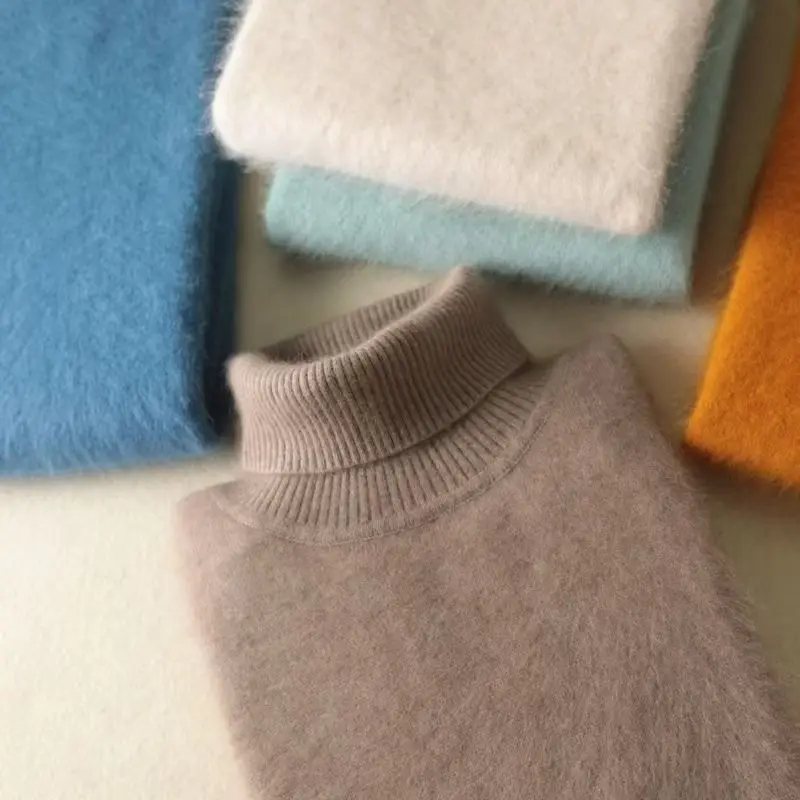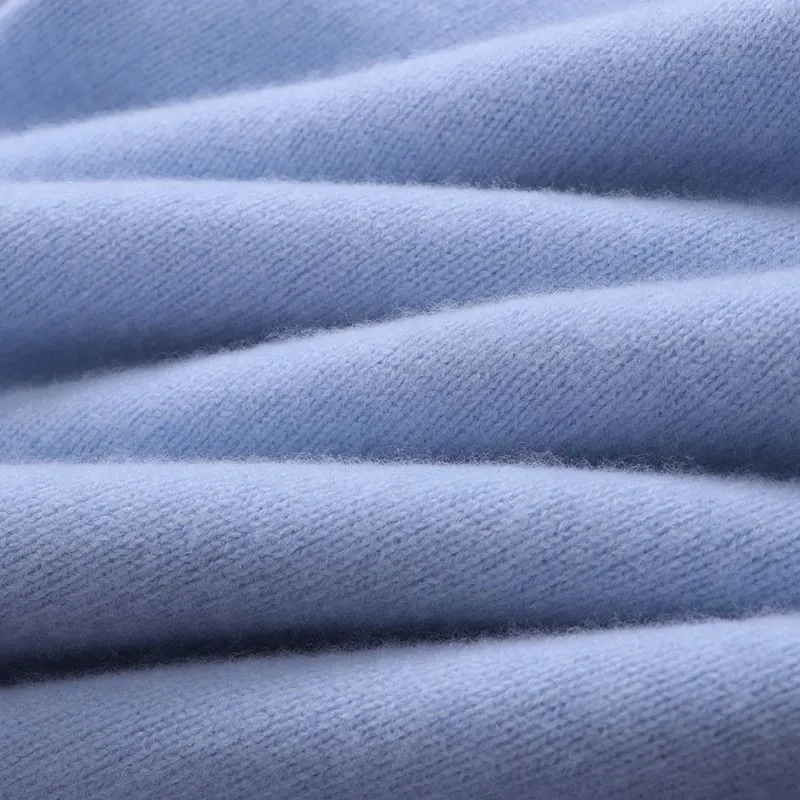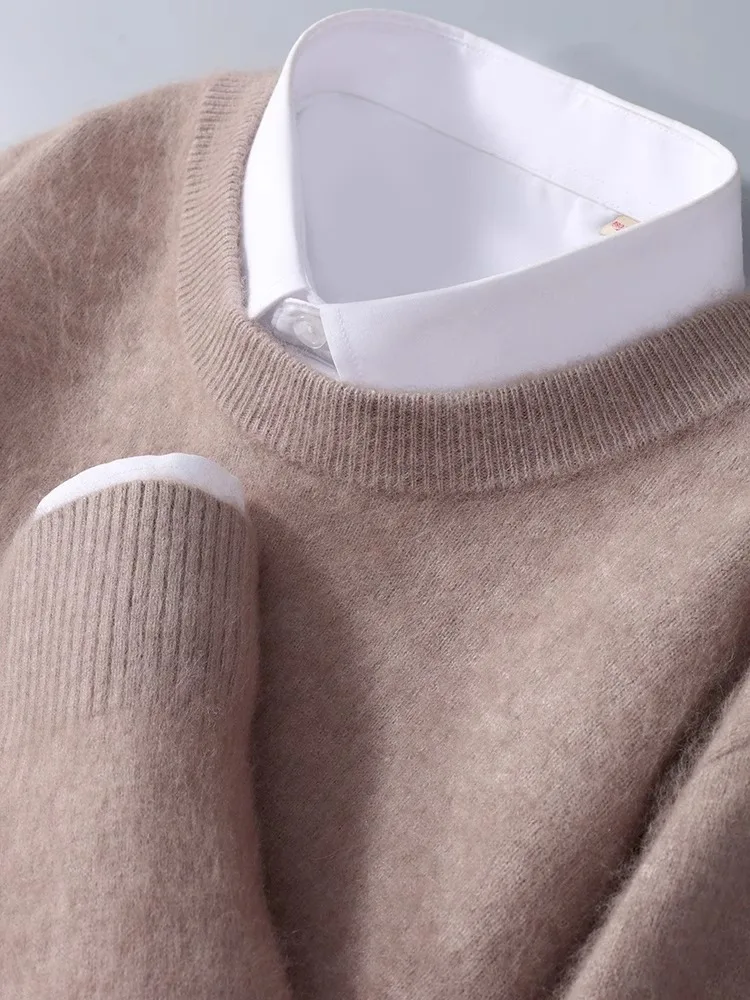What “100% Cashmere” Truly Means in Premium Sweaters
When a sweater is labeled “100% cashmere,” it means the garment is crafted entirely from the fine undercoat fibers of the Capra hircus goat—commonly known as the cashmere goat. These special goats thrive in harsh, cold climates of high-altitude regions across Mongolia, the Himalayas, and Inner Asia, where they develop an exceptionally soft undercoat to protect against extreme temperatures.
Unlike regular wool harvesting, cashmere collection follows a more delicate process. During the spring molting season, the fine undercoat is carefully combed from the goats rather than sheared. This gentle harvesting method preserves the integrity and length of these precious fibers.
Pure Cashmere Definition: In the textile industry, a “100% cashmere” label legally requires a minimum of 97% pure cashmere fiber content, though premium producers like Estate Cloth typically maintain true 100% purity in their garments.
The distinction matters significantly to consumers because true 100% cashmere delivers unparalleled performance characteristics that simply cannot be replicated by blends or synthetic alternatives. Understanding the comprehensive guide cashmere yarn weight provides valuable insight into why pure cashmere fiber quality creates such exceptional garments.
The geographical origin of these fibers contributes significantly to their quality, with Mongolian and Inner Asian regions typically producing some of the finest cashmere in the world. These natural factors combine to create a material that stands alone in the luxury fiber category.
The Exceptional Qualities That Make Pure Cashmere Luxurious
Pure cashmere possesses a unique combination of properties that elevates it above other natural and synthetic fibers. These exceptional characteristics explain why genuine cashmere garments command such admiration and value.
Unmatched Softness
- Cashmere fibers measure between 14-19 microns in diameter, dramatically finer than regular wool (25+ microns)
- This extreme fineness creates a silky touch against skin without the itchiness associated with conventional wool
- The natural crimp and flexibility of cashmere fibers enhance their tactile quality
Remarkable Warmth-to-Weight Ratio
- Cashmere provides up to eight times more insulation than regular sheep’s wool
- The microscopic structure of cashmere fibers creates tiny air pockets that trap body heat
- This thermal efficiency allows for lightweight garments that provide exceptional warmth
Breathability and Comfort
Despite its impressive insulation properties, cashmere remains highly breathable. This balance makes it uniquely versatile for temperature regulation, adapting to both cool and moderate conditions. Understanding cashmere yarn weights from lace to super bulky helps explain how different constructions enhance these natural properties.
Durability with Proper Care
Quality cashmere actually becomes softer with gentle wear and proper maintenance. The natural resilience of premium cashmere fibers allows garments to maintain their shape and appearance far longer than inferior materials. The 2-ply vs 4-ply cashmere guide details how fiber construction significantly impacts this longevity.
Elegant Drape and Appearance
Pure cashmere creates a natural, flowing drape that flatters the wearer while maintaining structure. This elegant presentation combines with a subtle natural luster that synthetic materials simply cannot duplicate.
Natural Hypoallergenic Properties
Cashmere contains minimal lanolin compared to regular wool, making it suitable for many people with wool sensitivities. This natural characteristic adds to its comfort for everyday wear.
How to Assess Cashmere Quality: The Key Indicators
Not all cashmere is created equal. Understanding the key quality indicators helps consumers identify truly exceptional cashmere garments worth their investment.
Fiber Length: The Foundation of Durability
Fiber length directly correlates with cashmere’s resistance to pilling and its overall longevity. Longer fibers can be twisted together more effectively during spinning, creating stronger yarn with fewer loose ends that might emerge as pills. Premium cashmere uses fibers exceeding 36mm in length, while lower-grade products may use fibers as short as 20mm.
Fiber Fineness: The Source of Softness
Measured in microns (μm), fiber diameter determines how soft cashmere feels against your skin. The finest cashmere fibers measure between 14-15.5 microns, creating that distinctive cloud-like softness that cashmere is famous for. Understanding cashmere ply thickness provides essential context for how these fibers translate into finished garments.
Cashmere Grades Comparison
| Grade | Fiber Diameter | Fiber Length | Characteristics | Typical Use |
|---|---|---|---|---|
| Grade A | 14-15.5 microns | 34-36mm+ | Exceptional softness, minimal pilling, superior warmth | Luxury sweaters, scarves |
| Grade B | 16-19 microns | 28-33mm | Good softness, moderate pilling resistance | Mid-range garments |
| Grade C | 19+ microns | Under 28mm | Less soft, prone to pilling, reduced durability | Blends, lower-cost items |
Knit Gauge and Density
The knit gauge (stitches per inch) significantly affects a garment’s weight, drape, and durability. Higher gauge numbers indicate finer, tighter knitting with more stitches per inch. Premium cashmere sweaters typically feature consistent, even stitching with appropriate density for their intended use – neither too loose (which reduces durability) nor too tight (which can reduce softness).
Ply Construction
Ply refers to how many strands of yarn are twisted together to create the final thread used in knitting. Single-ply cashmere is softest but most fragile, while multiple-ply constructions offer enhanced durability:
- 2-ply: Balance of softness and durability, ideal for everyday luxury sweaters
- 4-ply: Superior durability and structure, perfect for outerwear and long-term investment pieces
Finishing Techniques
Quality cashmere undergoes careful finishing processes that enhance its natural properties. These include gentle washing with specific pH-balanced formulas, controlled drying that maintains fiber integrity, and precise steaming or pressing that sets the garment’s dimensions without flattening its natural loft.

The Authentic Test: How to Identify Genuine 100% Cashmere
With premium cashmere commanding higher prices, it’s important to verify authenticity before purchasing. These practical methods help consumers identify genuine 100% cashmere garments.
Label Verification Beyond Marketing Claims
Look for detailed labeling that specifies:
* The exact fiber content (should state “100% cashmere”)
* Country of origin of the cashmere (not just manufacturing location)
* Care instructions specific to cashmere (not generic wool instructions)
Be wary of vague terms like “cashmere blend,” “cashmere feel,” or “cashmere-like” which often indicate minimal actual cashmere content.
The Touch Test Methodology
Authentic cashmere has a distinctive feel that’s difficult to replicate:
1. Gently run your hand across the surface – true cashmere feels incredibly soft yet slightly dry, not slippery or synthetic
2. Squeeze the fabric lightly – premium cashmere springs back readily without feeling limp
3. Rub the material between your fingers – quality cashmere warms quickly to your touch
Understanding how year-round cashmere comfort performs helps develop this tactile recognition.
Visual Inspection Techniques
Examine the garment carefully under good lighting:
* Look for consistency in the knit with even stitches throughout
* Quality cashmere has a subtle natural luster, not a shiny appearance
* Hold the garment up to light – premium cashmere has a uniform appearance without thin spots
Stretch and Recovery Test
Gently pull the fabric and observe its recovery:
1. Quality cashmere returns to its original shape quickly
2. Poor-quality or fake cashmere often stretches out or remains distorted
3. The elasticity should feel natural, not artificial or rigid
The Burn Test (For Experts)
While not recommended for store purchases, this test helps identify fiber content at home:
* Pure cashmere burns slowly with minimal flame
* It produces a faint burning hair smell rather than a chemical odor
* The ash is crushable between fingers, unlike synthetic fibers that form hard beads
Price as a Quality Indicator
While not foolproof, price offers context for authenticity:
* Extremely low-priced “100% cashmere” items should raise suspicion
* Quality cashmere sweaters typically start around $150-200 at minimum
* Ultra-luxury pieces often range from $400-1000+ depending on construction
Why Genuine 100% Cashmere Commands Premium Prices
The significant price difference between authentic cashmere and ordinary wool or synthetic garments stems from several inherent factors in its production and processing.
Limited Natural Yield
Each cashmere goat produces only 150-200 grams of usable down annually – barely enough for one-third of a sweater. This means a single sweater requires the annual harvest from 3-4 goats, creating a natural scarcity.
Production Reality: Approximately 10,000 tons of cashmere are produced globally each year, compared to over 2 million tons of regular wool.
Labor-Intensive Collection and Processing
The traditional harvesting method involves carefully combing each goat by hand during the spring molting season. After collection, the coarse outer guard hairs must be meticulously separated from the fine undercoat, often through a combination of mechanical and hand-sorting processes requiring skilled workers.
Geographic and Seasonal Limitations
Authentic cashmere comes primarily from specific high-altitude regions with harsh climates that stimulate the growth of the finest undercoat. This geographical limitation, combined with the seasonal nature of harvesting, restricts production capacity.
Premium cashmere sweaters require significantly more time to produce than standard knitwear. A quality cashmere sweater may undergo up to 30 separate production steps, with skilled artisans overseeing critical phases of yarn creation and garment construction.
The Long-Term Value Equation
While the initial investment is higher, quality cashmere offers superior value over time:
* A well-maintained premium cashmere sweater often lasts 10+ years
* The comfort and appearance remain consistent through proper care
* The classic styling of quality cashmere transcends seasonal trends
When calculated on a cost-per-wear basis, premium cashmere often proves more economical than lower-quality alternatives that require frequent replacement.
Essential Care Guide for Your 100% Cashmere Investment
Proper maintenance significantly extends the lifespan of your cashmere garments, preserving their luxurious qualities for years to come.
Washing Your Cashmere
- Hand washing is ideal: Use lukewarm water (never hot) with a mild detergent specifically formulated for wool or cashmere
- Gentle technique: Swish the garment gently without rubbing or wringing
- Rinse thoroughly: Remove all soap residue with cool water
- Press water out: Gently press excess water out between clean towels
Proper Drying Methods
- Lay the garment flat on a clean, dry towel
- Reshape carefully to original dimensions while damp
- Keep away from direct heat sources and sunlight
- Allow to air dry completely before storing
Optimal Storage Practices
- Always clean before storing: Even invisible soil attracts moths
- Fold, don’t hang: Hanging stretches cashmere fibers
- Use breathable containers: Cotton storage bags are ideal
- Include cedar blocks or lavender sachets: Natural moth deterrents
- Store in cool, dry places: Avoid humid areas that encourage mildew
Pilling Management
Some pilling is natural with even the highest quality mens cashmere turtlenecks and other garments:
- Use a cashmere comb or specialized fabric shaver
- Gently remove pills with light, directional strokes
- Address pilling promptly before it worsens
- Pilling typically decreases after the first few wears and cleanings

Seasonal Considerations
- End-of-season care: Always clean before summer storage
- Rotation strategy: Rest garments 24-48 hours between wearings
- Winter protection: Shield from rough surfaces that cause abrasion
Professional Cleaning
Consider professional dry cleaning for heavily soiled garments or at the end of the season, but choose cleaners experienced with luxury fibers and specify that the garment is 100% cashmere.
Cashmere Wrap Sweaters, Women's Cashmere Pullovers
$75.89 Select options This product has multiple variants. The options may be chosen on the product pageCashmere Cable Knit Sweaters, Women's Cashmere Pullovers
Price range: $111.82 through $112.93 Select options This product has multiple variants. The options may be chosen on the product pageCropped Cashmere Sweaters, Women's Cashmere Pullovers
$155.77 Select options This product has multiple variants. The options may be chosen on the product pageOversized Cashmere Sweaters, Plus Size Cashmere Sweaters, Women's V-Neck Cashmere Sweaters
$136.87 Select options This product has multiple variants. The options may be chosen on the product page- Price range: $108.11 through $130.03 Select options This product has multiple variants. The options may be chosen on the product page
Striped Cashmere Sweaters, Women's Cashmere Pullovers
$139.68 Select options This product has multiple variants. The options may be chosen on the product page
Common Misconceptions About Pure Cashmere
Myth: All cashmere pills excessively
Fact: High-quality cashmere with longer fibers pills minimally after initial wears. Excessive pilling typically indicates lower grade fibers or improper care. Premium garments actually stabilize after a few gentle cleanings.
Myth: Cashmere is too delicate for regular wear
Fact: While requiring appropriate care, quality cashmere is remarkably durable for a luxury fiber. Many mens cashmere pullovers are specifically designed for everyday wear, developing enhanced softness and character with proper use.
Myth: Cashmere cannot be washed at home
Fact: Most quality cashmere can be safely hand-washed using appropriate techniques and mild detergents. This gentle cleaning actually preserves the natural oils in the fibers better than harsh dry cleaning chemicals.
Myth: Softness is the only quality indicator
Fact: While softness is important, truly superior cashmere balances softness with appropriate resilience, recovery, and fiber integrity. Some inferior products are chemically treated for initial softness but quickly deteriorate.
Myth: All cashmere comes from the same source
Fact: Significant quality variations exist based on geographic origin, with different regions producing distinct fiber characteristics. The finest cashmere typically comes from specific high-altitude areas where goats develop exceptionally fine undercoats.
Is 100% Cashmere Worth the Investment? A Value Analysis
When evaluating the investment value of 100% cashmere, several factors contribute to its long-term worth beyond the initial purchase price.
Quality cashmere garments routinely last for decades with proper care, far outlasting synthetic alternatives or lower-quality natural fibers. This extended lifespan dramatically reduces the actual cost when calculated per wearing.
The versatility of cashmere also enhances its value proposition. Oversized cashmere sweaters transition seamlessly from casual daytime wear to elegant evening settings, reducing the need for multiple garments for different occasions. This adaptability extends across seasons as well – quality cashmere provides warmth in winter while remaining breathable enough for cool summer evenings.
From an environmental perspective, investing in lasting quality over disposable fashion represents more sustainable consumption. A single premium cashmere piece that serves for ten years creates significantly less environmental impact than multiple short-lived garments requiring repeated replacement.
The inclusive nature of quality cashmere also adds to its value, with plus-size cashmere sweaters offering the same exceptional comfort and elegance for all body types. This universal appeal transcends temporary trends, creating timeless wardrobe staples.

When all factors are considered – longevity, versatility, comfort, appearance, and sustainability – 100% cashmere represents not merely a purchase but a genuine investment in daily luxury that delivers returns in comfort and confidence with every wearing.







